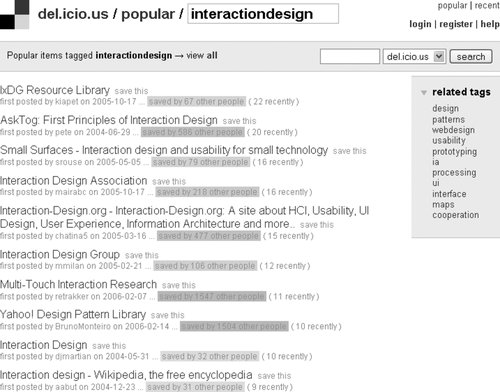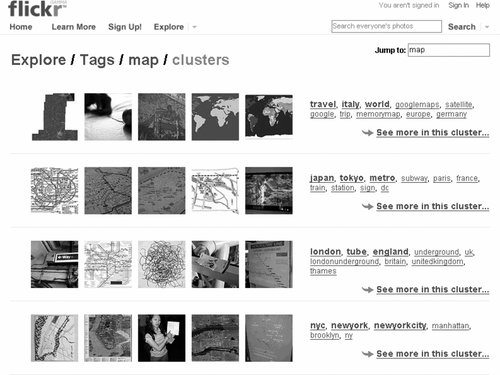Section 5.5. Social Classification
5.5. Social ClassificationIn recent years, user participatory systems have captured the attention and imagination of many in the web design community. High profile successes such as Flickr and del.icio.us have demonstrated the potential to enlist users in content creation and classification, and they've sparked tremendous enthusiasm for tagging as a form of description and organization. Free tagging, also known as collaborative categorization, mob indexing, and ethnoclassification, is a simple yet powerful tool. Users tag objects with one or more keywords. The tags are public and serve as pivots for social navigation. Users can move fluidly between objects, authors, tags, and indexers. And when large numbers of people get involved, interesting opportunities arise to transform user behavior and tagging patterns into new organization and navigation systems. For instance, in Figure 5-18, we see that the "IxDG Resource Library" is the most frequently bookmarked site that's been tagged with interactiondesign, and we can easily explore related tags such as design, patterns, ia, and ui. No single person or centralized team created a taxonomy to define these relationships. Rather, they emerged (and continue to emerge) through the tagging efforts of many individuals. Figure 5-18. Popular items on del.icio.us Similarly, Flickr has developed clustering algorithms (Figure 5-19) that group photos with overlapping tag sets, thereby creating emergent, self-describing taxonomies. Figure 5-19. Clustering on Flickr From an information architect's perspective, these experiments in the co-creation of structure and organization are fascinating. And, as you might expect, we can't resist labeling the new phenomenon. For instance, on an information architecture mailing list, Gene Smith described the growing use of user-defined tags to organize information, and asked, "Is there a name for this kind of informal social classification?" After a brief discussion, Thomas Vander Wal replied: So the user-created bottom-up categorical structure development with an emergent thesaurus would become a Folksonomy?[
Of course, the tagging revolution hasn't come without a cost. In their enthusiasm for the new, many overzealous pundits have forecast the demise of traditional forms of organization. For example, David Sifry, founder and CEO of Technorati, stated: Tags are a simple, yet powerful, social software innovation. Today millions of people are freely and openly assigning metadata to content and conversations. Unlike rigid taxonomy schemes that people dislike, the ease of tagging for personal organization with social incentives leads to a rich and discoverable folksonomy. Intelligence is provided by real people from the bottom-up to aid social discovery. And with the right tag search and navigation, folksonomy outperforms more structured approaches to classification.[
And, in a debate with Lou Rosenfeld, Clay Shirky argued: The advantage of folksonomies isn't that they're better than controlled vocabularies, it's that they're better than nothing, because controlled vocabularies are not extensible to the majority of cases where tagging is needed...This is something the 'well-designed metadata' crowd has never understood...the cost of tagging large systems rigorously is crippling, so fantasies of using controlled metadata in environments like Flickr are really fantasies of users suddenly deciding to become disciples of information architecture.[§§]
These colorful statements play well in the blogosphere, but they are neither fair nor accurate. First, there's simply no evidence to suggest that folksonomy outperforms traditional approaches to organization, and anyone who searches Flickr can see first-hand the findability problems that come with the complete absence of vocabulary control. Second, these arguments ignore the critical importance of context. To date, tagging has flourished in a very limited set of environments. This is why the same examples, Flickr and del.icio.us, are used over and over again. It remains to be seen whether social classification can be successfully integrated into a wider range of web sites, intranets, and interactive products. Hopefully, information architects will embrace this challenge, and play a leadership role in the synthesis of traditional and novel ways of organizing. In many contexts, we will continue to structure and organize information on behalf of our users. In others, we will design environments and tools that enlist our users in folksonomic acts of co-creation. And on some projects, we'll have the opportunity to bridge the gap, using both tags and taxonomies to connect users with the content they seek. |
EAN: 2147483647
Pages: 194


